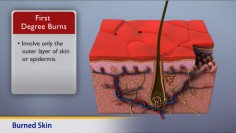
Burns: Hot Water Safety
The leading cause of deaths and injuries to children at home is accidents. Hot water burns can put a child in the hospital or even cause death. The burns occur most often in the bathroom and tend to be more severe because a larger portion of the body is burned. Children ages 4 and younger are at the greatest risk for death due to burn-related injuries.
Small children can get to sinks or bathtubs quickly. They can get badly burned before they can get out of the water. Infants are unable to move away from hot water if it is accidentally left on too hot or the cold water is turned off. Here are some tips:
- When using tap water, always turn on the cold water first, and then add hot. When finished, turn the hot water off first.
- Always test the water before your child gets into the tub or shower.
- Don't allow young children to touch faucet handles during the bath.
- Make sure all faucets are properly labeled “HOT” or “COLD.”
- Do not use hot steam vaporizers. They can cause steam burns. Use a cool mist vaporizer.
- Never leave a child alone in the bathroom for any reason. They are at risk for getting burned by hot water or drowning.
- Set the thermostat on your water heater to 120°F (48°C) or lower. A child can be scalded in 2 to 3 seconds in water that is only 5 degrees higher - 125°F (52°C).
- If you are unable to control the water temperature (because you live in an apartment for example), you can install antiscald devices on faucets and showerheads. An antiscald device is relatively inexpensive and can easily be installed by you or a plumber. The device will sense the water temperature and keep it from getting over 120°F (49°C).
Here are some common questions and answers about hot water heater settings.
If I turn the hot water heater setting down, will the dishes in the dishwasher and the clothes in the washing machine still get clean?
Yes. Soap works best in water between 120°F and 125°F (48°C to 52°C).
Will my baby get more colds if the hot water isn't hot enough?
No. Hot water has nothing to do with getting colds.
Will I save money on utility bills by turning down the temperature setting?
Yes. On the average, for every 10°F (6°C) that you turn the temperature down, you will save 4% on the water-heating portion of your utility bill.
I don't know where the thermostat of my hot water heater is, and I don't know how to set the temperature. Who can help?
Call your local utility company to adjust the thermostat. Some companies offer this service at no-charge. Gas hot water heaters usually have a thermostat outside the tank at the bottom. Electric water heaters usually have either panels screwed to the top and bottom of the tank or one panel along the side of the tank. Thermostats are located under these panels. The thermostat should be set on the "low" setting.
After changing the thermostat setting, test the hot water temperature in about 24 hours. If you test it in less than 24 hours, you may not get an accurate reading. Continue to test the water temperature and adjust the thermostat setting until the water is 120°F (48°C).
Last modified: 2012-03-16
Last reviewed: 2009-12-01

